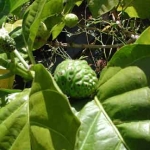| Common Name: |
Noni |
| Other Names: |
Awl Tree, Hog Apple, Indian Mulberry. Mengkudu, Morinda, Wild Pine. |
| Botanical Name: |
Morinda citrifolia |
| Genus: |
Morinda |
| Family: |
Rubiaceae |
| Native Location: |
Tropical Asia, Australia, and Polynesia |
| Cultivation: |
Well-drained, sandy soil in sun. Tolerates saline conditions. |
| Propagation: |
By seed sown when ripe at 18-21°C (64-70°F); by semi-ripe cuttings in summer at 18°C (64°F) |
| Harvest: |
Leaves are picked during the growing season and dried for use in infusions. Ripe seeds are collected in the autumn and ground for pastes. |
| Height: |
3m (10ft) |
| Width: |
2-2.5m(6-8ft) |
| Hardiness: |
Min. 15-18°C (59-64°F) |
| Parts Used: |
Roots (ba ji), leaves, fruits, juice. |
| Properties: |
An astringent, purgative herb that reduces inflammation. |
| Medicinal Uses: |
Internally for dysentery, hemorrhage (fruits), constipation (roots), tuberculosis (leaves). Externally for gout (leaf juice), chronic ulcers, snakebite (leaves), and gum disease (fruits).
To treat diabetes, fever, and stomachache; to purify the blood. |
| Possible Side Effects: |
Noni's side effects include nausea, vomiting, anorexia, sedation, allergic reactions, and hyperkalemia (high levels of potassium in the blood) |
| Drug Interactions: |
| Taking noni with these drugs may increase the risk of hyperkalemia (high blood levels of potassium): |
| Amiloride, (Midamor) |
Hydrochlorothiazide and Triamterene, (Dyazide, Maxzide) |
| Spironolactone, (Aldactone, Novo-Spiroton) |
Triamterene, (Dyrenium) |
| Taking noni with these drugs may interfere with the action of the drug: |
| Cyclosporine, (Neoral, Sandimmune) |
Dexamethasone, (Decadron, Dexasone) |
Prednisone, (Apo-Prednisone, Deltasone) |
|
| Lab Test Alterations: |
May confound results of diagnostic urine tests that rely on color change by discoloring urine (pink, red, purple, or orange). |
| Disease Effects: |
May worsen cases of elevated potassium levels (hyperkalemia) due to potassium in noni. |
| Culinary Uses: |
Unripe fruits are eatin in curries and sambals. Juice of ripe fruits is used in sauces, dressings, and marinades in Australian bush cuisine. Young leaves are eaten raw, cooked as a vegetable, or used for wrapping in fish dishes. |
| Bibliography: |
Encyclopedia of Herbs by Deni Brown Copyright © 1995, 2001 Dorling Kindersley Limited. Pp 281-282
The Essential Herb-Drug-Vitamin Interaction Guide by Geo. T. Grossberg,MD and Barry Fox,PhD Copyright©2007 Barry Fox,PhD. Pp. 348-349 |

